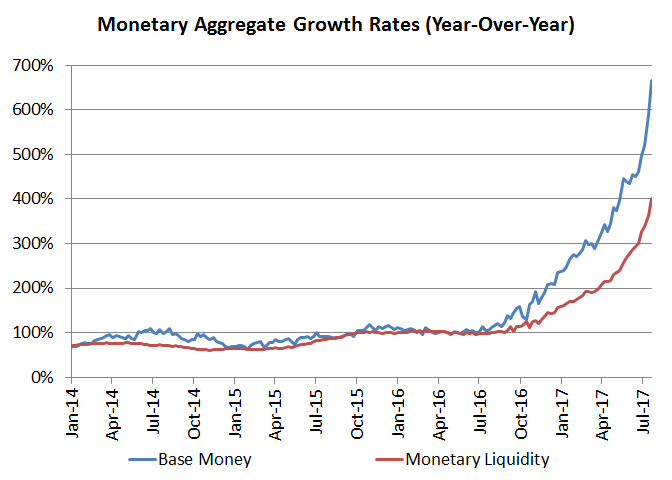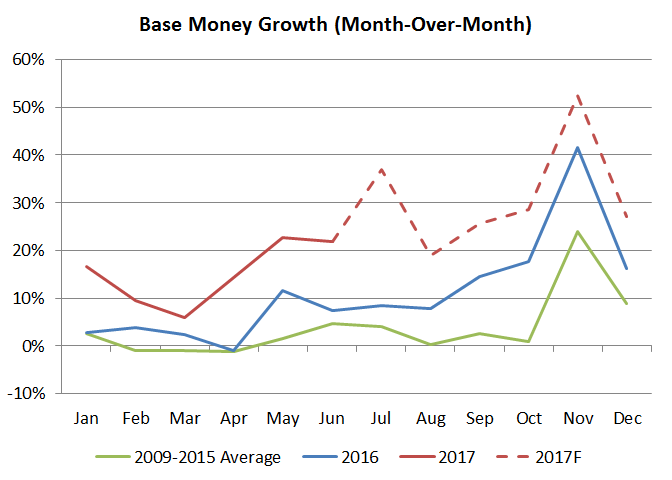Three Million Percent Later
The bolivar lost two thirds of it's value on the black market in 77 days. We unpack the currency's collapse.


The black market exchange rate blew past 17,280 VEF/$ today, evaporating two-thirds of the value our currency had on May 18th, when the rate was 5,760. That day, just 77 days ago, the exchange rate was up a million percent from Chavez’s swearing in on February 2nd, 1999. Today, it’s up three million percent.
My guess: the FX rate could be over 30-40 thousand VEF/$ by 2018 if there are no substantive changes in policy. Why? Venezuela’s Central Bank is creating Bolivares at an unprecedented rate to fund the government’s deficit, so other things equal, nominal variables in the economy like prices and the exchange rate should keep pace. Base money — the stock of currency the Central Bank creates — is up 666% in the last 12 months and rising fast. Just last week, it spiked 13%. Venezuela’s catastrophe is a gut-wrenching rerun of Latin America’s economic failures from the 20th century, only worse. It’s the the predictable, agonizing aftermath of macroeconomic populism. The story is well known:
Venezuela’s catastrophe is a gut-wrenching rerun of Latin America’s economic failures from the 20th century, only worse. It’s the the predictable, agonizing aftermath of macroeconomic populism. The story is well known:
In the beginning, the government stages a consumption and import boom with a large fiscal expansion and overvalued exchange rate. The whole thing is propped up with voodoo economic controls and funded by high commodity prices or debt or both. It works for a while.
In the middle, the economy begins to lose steam and shortages pop up. The controls to mitigate the bottlenecks only make things worse. The growth and gains are unsustainable, and eventually, they stop. Later, they reverse.
In the end, there’s a shock or crisis that the system can’t weather (in our case lower oil prices), and the whole thing falls to pieces. Imports are gutted and per capita GDP craters. The currency is wiped out and real wages fall below their initial level. Poverty balloons.
Maduro could end the nightmare as our Latin American peers did by visiting the IMF and rationalizing policy — but he doesn’t care to. Instead, he’s inviting U.S. sanctions and consolidating a malevolent totalitarian project while the crisis spirals out of control. For the economy to enter hyperinflation, prices have to rise more than 50% a month. Well, base money grew by 40% in the last 4 weeks. We’re getting there.
To be honest, I’m surprised it took so long for shit to hit the fan.
Even as late as 2009-2015 (green line below), inflation and Central Bank financing of the government’s deficit (i.e. money printing) was high but under control. The government would mostly monetize the deficit towards year-end to pay bonuses to three million people on the public payroll and keep Central Bank financing in low gear otherwise. Base money would spike in November and December but grow just 0-5% per month the rest of the year. That changed in May 2016 when the government started printing money like it was Christmas the whole year (blue line above). As imports, the economy and real tax collections tanked, the government doubled down on the Central Bank’s printing press to make up the difference. As a result, base money grew by 236% in 2016, four times the average growth in 2009-2015.
That changed in May 2016 when the government started printing money like it was Christmas the whole year (blue line above). As imports, the economy and real tax collections tanked, the government doubled down on the Central Bank’s printing press to make up the difference. As a result, base money grew by 236% in 2016, four times the average growth in 2009-2015.
By 2017, the government was fully reliant on direct Central Bank financing. This June, just 39% of the budget was funded with ordinary tax collections and DICOM dollar sales, while the remaining 61% was funded with freshly printed cash. It’s crazy: the government now prints more money than it collects from dollar sales, VAT, income tax, and all other taxes combined, and not just in November/December but every month. We don’t have full July data yet, but my best guess is that the government printed a record three or four times as much money as it collected via taxes and DICOM dollar sales.
Absent significant changes, humanitarian and economic conditions in Venezuela will continue to deteriorate. A basic extrapolation of recent trends suggests monetary liquidity could rise to 100 trillion VEF by year-end from 27 trillion now, implying prices and the exchange rate might triple or quadruple through December. Wages won’t keep up, poverty and shortages will deepen, and people will die. This train-wreck is no longer in slow motion, and Maduro wants to drag it out all the way to hell.
Caracas Chronicles is 100% reader-supported.
We’ve been able to hang on for 22 years in one of the craziest media landscapes in the world. We’ve seen different media outlets in Venezuela (and abroad) closing shop, something we’re looking to avoid at all costs. Your collaboration goes a long way in helping us weather the storm.
Donate





